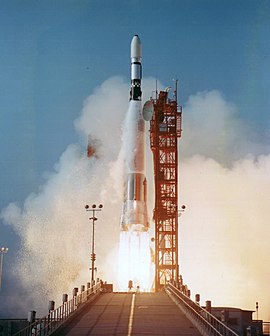Atlas-Agena

An Atlas-Agena launching Lunar Orbiter 4
|
|
| Function | Expendable launch system |
|---|---|
| Manufacturer |
Convair General Dynamics |
| Country of origin | United States |
| Size | |
| Height | 118.0 feet (36.0 m) |
| Diameter | 10.0 feet (3.0 m) |
| Width | 16.0 feet (4.9 m) |
| Mass | 341,000 pounds (155,000 kg) |
| Stages | 2½ |
| Capacity | |
| Payload to LEO | 2,200 pounds (1,000 kg) |
| Payload to GEO | 1,540 pounds (700 kg) |
| Payload to TLI | 850 pounds (390 kg) |
| Payload to escape | 575 pounds (261 kg) |
| Launch history | |
| Status | Retired |
| Launch sites |
LC-12, 13 & 14, CCAFS SLC-3 & 4, Vandenberg |
| Total launches | 109 |
| Successes | 93 |
| Failures | 13 |
| Partial failures | 3 |
| First flight | 26 February 1960 |
| Last flight | 27 June 1978 |
| Boosters | |
| No. boosters | 1 |
| Width | 16.0 feet (4.9 m) |
| Engines | 2 |
| Thrust | 233,000 pounds-force (1,040 kN) |
| Burn time | 134 seconds |
| Fuel | RP-1/LOX |
| First stage | |
| Diameter | 10.0 feet (3.0 m) |
| Engines | 1 |
| Thrust | 67,000 pounds-force (300 kN) |
| Burn time | 5 minutes |
| Fuel | RP-1/LOX |
| Second stage - Agena D | |
| Length | 248 inches (6.3 m) |
| Diameter | 5.0 feet (1.5 m) |
| Engines | 1 Bell Aerospace 8247 |
| Thrust | 16,000 pounds-force (71 kN) |
| Burn time | 265 seconds |
| Fuel | UDMH/IRFNA |
The Atlas-Agena was an American expendable launch system derived from the SM-65 Atlas missile. It was a member of the Atlas family of rockets, and was launched 109 times between 1960 and 1978. It was used to launch the first five Mariner unmanned probes to the planets Venus and Mars, and the Ranger and Lunar Orbiter unmanned probes to the Moon. The upper stage was also used as an unmanned orbital target vehicle for the Gemini manned spacecraft to practice rendezvous and docking. However, the launch vehicle family was originally developed for the Air Force and most of its launches were classified DoD payloads.
The Atlas-Agena was a two-and-a-half-stage rocket, with a stage-and-a-half Atlas missile as the first stage, and an RM-81 Agena second stage. Initially, Atlas D missiles, redesignated as the LV-3, were used as the first stage. These were later replaced by the standardized Atlas SLV-3, and its derivatives, the SLV-3A and B. The final Atlas-Agena launch used an Atlas E/F.
The earliest Agena variant was the Agena A in 1959-60, which did not have restart capability. Most of these were flown on Thor-Agena boosters for the Discoverer program and only four used Atlases (Midas 1, Midas 2, Samos 1, and Samos 2), two of which failed.
Late in 1960, Lockheed introduced the uprated Agena B stage which was restartable and had longer propellant tanks for more burn time. It first flew on the Thor and did not make its maiden voyage on an Atlas for months, when Midas 3 launched on July 12, 1961. Atlas-Agenas were then used for DoD and NASA programs, but proved a reliability nightmare as one failure after another happened. In late 1962, after Ranger 5 suffered another booster malfunction (albeit a minor one that ground controllers were able to work around), NASA convened a review board which undertook a wholesale reevaluation of the Atlas-Agena as a launch vehicle. The board found that quality control and checkout procedures were poor, and that this situation was exacerbated by the several dozen configurations of the booster, as each individual DoD and NASA program necessitated custom modifications to the Atlas and Agena, and the latter also differed in its Atlas and Thor variants. The board recommended improved quality control, better hardware, and also establishing one standardized launch vehicle for all space programs.
...
Wikipedia
